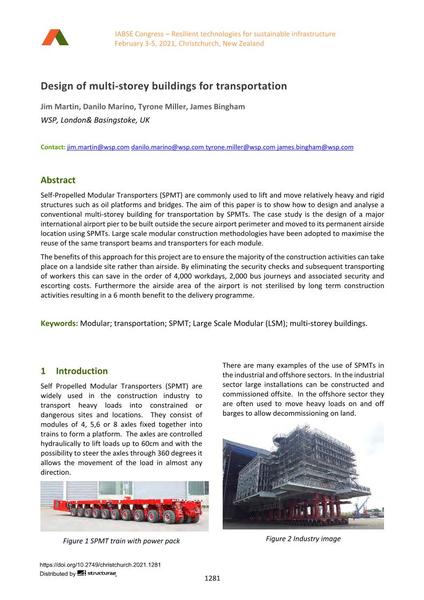Design of multi-storey buildings for transportation

|
|
|||||||||||
Bibliografische Angaben
| Autor(en): |
Jim Martin
(WSP, London& Basingstoke, UK)
Danilo Marino (WSP, London& Basingstoke, UK) Tyrone Miller (WSP, London& Basingstoke, UK) James Bingham (WSP, London& Basingstoke, UK) |
||||
|---|---|---|---|---|---|
| Medium: | Tagungsbeitrag | ||||
| Sprache(n): | Englisch | ||||
| Tagung: | IABSE Congress: Resilient technologies for sustainable infrastructure, Christchurch, New Zealand, 3-5 February 2021 | ||||
| Veröffentlicht in: | IABSE Congress Christchurch 2020 | ||||
|
|||||
| Seite(n): | 1281-1288 | ||||
| Anzahl der Seiten (im PDF): | 8 | ||||
| DOI: | 10.2749/christchurch.2021.1281 | ||||
| Abstrakt: |
Self-Propelled Modular Transporters (SPMT) are commonly used to lift and move relatively heavy and rigid structures such as oil platforms and bridges. The aim of this paper is to show how to design and analyse a conventional multi-storey building for transportation by SPMTs. The case study is the design of a major international airport pier to be built outside the secure airport perimeter and moved to its permanent airside location using SPMTs. Large scale modular construction methodologies have been adopted to maximise the reuse of the same transport beams and transporters for each module. The benefits of this approach for this project are to ensure the majority of the construction activities can take place on a landside site rather than airside. By eliminating the security checks and subsequent transporting of workers this can save in the order of 4,000 workdays, 2,000 bus journeys and associated security and escorting costs. Furthermore the airside area of the airport is not sterilised by long term construction activities resulting in a 6 month benefit to the delivery programme. |
||||
| Stichwörter: |
Transport
|
||||
